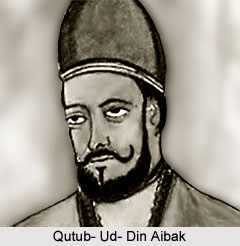 Slave dynasty or the Delhi Sultanate laid the foundation of its vast empire after the victory in the Battle of Tarain in 1192 AD.Mohammad Ghori defeated and killed Phrithiviraj Chauhan III in the Tarain Slave Dynasty ruled India for 84 years. The Muslim religion was introduced in India with the establishment of Turkish rule. Delhi became the first capital under Turkish rule. Muhammad Ghori used to raid in India and eventually conquered Delhi. Qutub- Ud- Din Aibak, slave cum lieutenant assisted him in those expeditions. With the introduction of `Mamluks` scheme (Material slavery), Aibak became advantageous to rise up out of his birth status and achieved the right for higher position. This trusted slave of Muhammad Ghori became the in charge of North India. After the death of Ghori, Aibak became his successor. When Aibak, the slave raised to the status of Sultan, the equality concept in Islam reached to its highest position. The Slave Dynasty served as the first Turkish dynasty in India from 1206 to 1290. Qutub-ud-din Aibak, Shams-ud-din Iltutmish and Ghiyas-ud-din Balban were the prominent rulers of this era.
Slave dynasty or the Delhi Sultanate laid the foundation of its vast empire after the victory in the Battle of Tarain in 1192 AD.Mohammad Ghori defeated and killed Phrithiviraj Chauhan III in the Tarain Slave Dynasty ruled India for 84 years. The Muslim religion was introduced in India with the establishment of Turkish rule. Delhi became the first capital under Turkish rule. Muhammad Ghori used to raid in India and eventually conquered Delhi. Qutub- Ud- Din Aibak, slave cum lieutenant assisted him in those expeditions. With the introduction of `Mamluks` scheme (Material slavery), Aibak became advantageous to rise up out of his birth status and achieved the right for higher position. This trusted slave of Muhammad Ghori became the in charge of North India. After the death of Ghori, Aibak became his successor. When Aibak, the slave raised to the status of Sultan, the equality concept in Islam reached to its highest position. The Slave Dynasty served as the first Turkish dynasty in India from 1206 to 1290. Qutub-ud-din Aibak, Shams-ud-din Iltutmish and Ghiyas-ud-din Balban were the prominent rulers of this era.
Qutb-ud-din Aibak in Slave Dynasty
Qutb-ud-din Aibak exercised his rule over the provisions where he was the Ghori`s local receiver-general during the periodic expeditions. He initially ruled from Lahore to Delhi later developed as capital. Aibak during his period took initiative to construct Delhi`s earliest monuments like the `Qutub Minar` and the `Quwwat-ul-Islam mosque` which is called as the first mosque in Delhi. But these monuments remained incomplete as Aibak died accidentally in 1210 at Lahore. Aram Shah, the successor of Aibak turned to be an incapable ruler. The Sultanate of Delhi was facing some internal problems at that time. The `Chihalgani` or the `Corp of Forty` invited Shams-ud-din Iltutmish to replace Aram Shah.
Shams-ud-din Iltutmish in Slave Dynasty
Shams-ud-din Iltutmish, the successor of Aibak completed Aibak`s unfinished works. The column was named after Khwaja Qutub-ud-din. A mosque was also built on Sultan`s order. This Turkish slave turned Sultan, married to Aibak`s daughter. After becoming the Sultan, Iltutmish faced a feeling of indignation from the Amirs of Delhi. But he managed the resentment strongly. During the reign of Iltutmish, the Mongols attacked India for the first time under the leadership of Genghis Khan. In 1236 Iltutmish died. He nominated his daughter Raziya Sultana as his heiress on his death bed. Raziya Sultana and her husband Altunia were killed in their way to Delhi as the nobles of the court disagree to bow their hand in front of women. They offered the throne to the surviving son of Iltutmish, Rukh-ud-din Firuz. Bahram and Masad, next to successors were incompetent. The youngest son of Iltutmish, Nasiruddin Mahmud was raised as the Sultan in 1246.Mahmud used to spend more of his time in prayers. So that state affairs were managed by his Prime Minister Ghiyas-ud-din-Balban.
Ghiyas-ud-din-Balban
Ghiyas-ud-din-Balban declared himself the Sultan after the death of Nasiruddin. Mahumud. He paid more attention to the production of weapons. He broke down the `Chihalgani`. He ruled from 1266 till his death with a strong hand as he believed that the king should be very powerful. Ghiyas-ud-din-Balban adopted a blood and iron policy to maintain peace. He completed the task which was started by Iltutmish. He made the Muslim rule in India so strong that it lasted in one form or the other till 1857. Balban`s two son, one died before he could succeed and one refused the throne as he was the Governor of Bengal. Thus it made Balban to choose his grandson Kai Khusro to be the successor to ascend the throne. But when Balban died, the Muiz ud din Qaiqabad became the ruler. After four years of his reign, he suffered a paralytic stroke and was killed by the conspirators. His nobles replaced him by his three year old son Kaimus.
The most important institution that developed under the Slave Dynasty was the `Chihalgani` or the Forty. Iltutmish recognized them as his personal supporter. To strengthen his rule, Balban crushed the power of these forties, but actually this decision destroyed the real power of the Slave Dynasty. Jalal-ud-din Khilji overthrown the slave Dynasty and established the Khilji Dynasty.



















